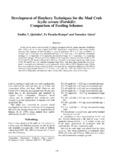Development of hatchery techniques for the mud crab Scylla serrata (Forskål): Comparison of feeding schemes
- Global styles
- MLA
- Vancouver
- Elsevier - Harvard
- APA
- Help

ดู/เปิด
วันที่
1999Page views
4,865ASFA keyword
AGROVOC keyword
Taxonomic term
เมตาดาต้า
แสดงระเบียนรายการเต็มShare
นามธรรม
Scylla serrata larvae were reared in 3 L plastic containers and fed various amounts of artificial diets (AD) with or without natural food (NF: Brachionus rotundiformis and newly-hatched Artemia). The amounts of AD fed alone to zoea in treatments (T) 1 to 4 were as follows: 1) 2.0 mg/L/day + 0.25 mg/L/day increment/substage; 2) 2.0 mg/L/day + 0.5 mg/L/day increment/ substage; 3) 4.0 mg/L/day + 0.5 mg/L/day increment/substage; 4) 4.0 mg/L/day + 1.0 mg/L/day increment/ substage. NF were given in addition to the respective amounts of artificial diet in T5, T6, T7 and T8. T9 served as the control (NF only). Based on three experimental runs, only larvae in T5, T6, and T9 survived until the megalopa stage. Thus, only these three treatments were compared in succeeding experiments using a commercial shrimp diet in 250 L fibreglass tanks. Of the three runs conducted using a commercial diet, two runs showed significant differences (P<0.05) in survival. T5 gave higher survival (3.71% and 1.33%) than T9 (1.84% and 0.45%) and T6 (1.37% and 0.45%). Population development index did not differ among treatments in three runs.
การอ้างอิง
Quinitio, E. T., Parado-Estepa, F., & Alava, V. (1999). Development of hatchery techniques for the mud crab Scylla serrata (Forskål): Comparison of feeding schemes. In C. P. Keenan & A. Blackshaw (Eds.), Mud Crab Aquaculture and Biology. Proceedings of an international scientific forum held in Darwin, Australia, 21–24 April 1997 (pp. 125-130). Canberra: Australian Centre for International Agricultural Research.
Type
Conference paperคอลเลกชัน
- Conference Proceedings [298]
Related items
Showing items related by title, author, creator and subject.
-
[The Philippines recommends for mangrove crab:] Biology of mangrove crab
The Mangrove Crab Technical Committee 2018 (DOST-PCAARRD, 2021) -
Larval rearing of mud crab (Scylla): What lies ahead
Waiho, Khor; Fazhan, Hanafiah; Quinitio, Emilia T. ; Baylon, Juliana C.; Fujaya, Yushinta; Azmie, Ghazali; Wu, Qingyang; Shi, Xi; Ikhwanuddin, Mhd; Ma, Hongyu (Elsevier, 2018)
The increasing global demand for mud crabs (genus Scylla) and threats to the wild populations highlight the urgency of fully rearing them in captivity. Despite considerable progress in mud crab production, most crab farms ...
; Baylon, Juliana C.; Fujaya, Yushinta; Azmie, Ghazali; Wu, Qingyang; Shi, Xi; Ikhwanuddin, Mhd; Ma, Hongyu (Elsevier, 2018)
The increasing global demand for mud crabs (genus Scylla) and threats to the wild populations highlight the urgency of fully rearing them in captivity. Despite considerable progress in mud crab production, most crab farms ...
-
Development of protocol for the production of hatchery-reared mud crab Scylla serrata juveniles for soft-shell crab farming
Quinitio, Emilia T. ; Libunao, Gardel Xyza; Parado-Estepa, Fe D. (Aquaculture Department, Southeast Asian Fisheries Development Center, 2017)
Development of economically viable techniques for growing hatchery-reared juvenile crabs to suitable sizes will address the problem on the source of seed stocks for soft-shell crab farming. This paper reports the production ...
; Libunao, Gardel Xyza; Parado-Estepa, Fe D. (Aquaculture Department, Southeast Asian Fisheries Development Center, 2017)
Development of economically viable techniques for growing hatchery-reared juvenile crabs to suitable sizes will address the problem on the source of seed stocks for soft-shell crab farming. This paper reports the production ...





